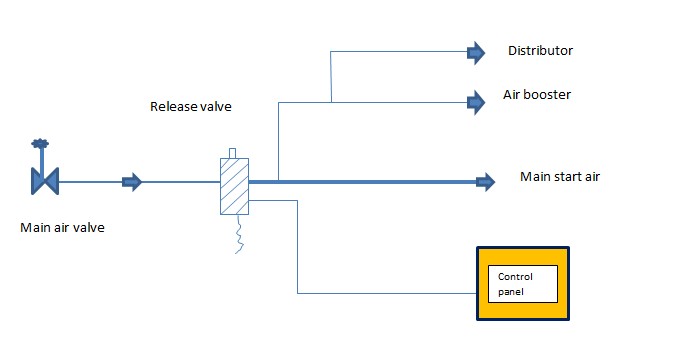Diesel marine engine air starting system
Learn about diesel marine engine air starting systems, engine air starting systems problems, and providing reliable solutions for efficient engine startups in challenging marine environments
Compressed air is used to start the diesel engine prime mover in high capacity diesel power plants or a marine engine. In this method, air should be kept at 30 bar pressure in the compression vessel at all times. Compressed air strikes the piston at TDC to rotate the crankshaft.

Start signal should be given from the engine control panel or monitoring unit to run the engine normally. Before that, the valve of the start air line should be opened so that the air reaches the release valve. As soon as the engine start button is clicked, a signal (current) opens the release valve, and air flows into the pilot valve of the cylinder head. An air distributor operates the pilot valve, which admits the main air into each cylinder and starts the engine. The function of the air start is to raise the engine speed up to 50 RPM, from which the governor begins to function.
Air boosters are used in addition to the main air system. These boosters help bring the governor into function quickly by applying oil pressure to it. The governor then opens the fuel control shaft as quickly as possible, and the engine starts. Air boosters are mainly included in the system to bring the governor up to functionality quickly in the early stages. Without the boosters, the engine RPM would have to be maintained by air until the pressure is built up through the governor’s servo motor.
Components of engine air starting systems
- Control console
- Stop button
- Start button
- Micro switch (turning gear)
- Starting air valve (cylinder head)
- Main starting air pipe.
- Pilot air pipe
- Stop handles (on control shaft)
- Starting air release valve
- Pilot air distributor
- Pipe, lubr. Oil after filter
- Test cock for pressure switch
- Pressure switch
- Relief valve (bursting disk)
- Shut off-non return valve
- Start air bottle
Engine Air starting systems Problems and Remedies
1.Start switch blinking but no response from the release valve:
- This happens when the start signal does not reach the release valve or solenoid valve.
Remedy: Check the signal communication status.
2. Release valve active but RPM does not increase:
- Check for air leakage from the air release valve. Air may escape from the release point when the start button is pressed.
Remedy:
- Replace or service the valve.
3. Air escapes from the release point 2–3 seconds after pressing the start switch:
- The distributor does not pass air to the pilot valve.
- The rotating slide is not in the correct position.
Remedy:
- Turn the shaft properly.
- Service the air distributor.
4. Engine rotates slowly:
Possible causes:
- Engine lubricating oil temperature is too low.
- Main air pressure is insufficient.
- Engine cooling temperature is too low.
Remedy:
- Maintain the lubricating oil temperature as per SOP.
- Increase the starting air pressure.
- Preheat the engine to keep it warm.
5.Pilot valve does not operate:

Possible cause:
- Valve spring is stuck.
Remedy:
- Lubricate the valve spring manually using lubricating oil
Warning of open start air valve:
- Before open the start air main valve keep air bottle pressure up to 25 bars
- Keep bottle always condense drain condition
- Valve open and close should be slowly
Conclusion: The diesel marine engine air starting systems is essential for initiating the operation of marine engines or Disele power plant, utilizing compressed air to facilitate reliable and efficient engine start-up. Its effectiveness is crucial for ensuring optimal performance and operational readiness in marine applications or power plant.
